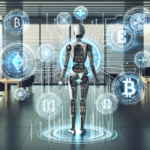The Evolution of Trading and Technology
Historical Context
Historically, trading was a straightforward affair, centered around the physical exchange of goods and commodities. The advent of technology changed that landscape dramatically. From the telegraph to the internet, each technological leap transformed the way trading operated. However, it wasn’t until the late 20th century that algorithms and computers began to play a pivotal role in trading decisions.
The Birth of Algorithmic Trading
The introduction of algorithmic trading marked a critical juncture. Traders started to use computer programs to execute trades based on predefined criteria. This evolution allowed for greater speed and efficiency in executing trades. Early adopters of these algorithms capitalized on market inefficiencies much quicker than human traders.
The Role of Big Data
As data collection and storage technologies improved, a wealth of information became available to traders. Financial markets generate vast amounts of data, ranging from historical prices to economic indicators. Big data analytics began to shape trading strategies, allowing for a more nuanced understanding of market dynamics. Traders started using these datasets to identify patterns and make predictions.
Artificial Intelligence: The Game Changer
What Is AI in Trading?
Artificial Intelligence (AI) encompasses a range of technologies that enable machines to simulate human intelligence. In the trading world, AI can analyze large datasets, recognize patterns, and make predictions about market movements. This capability is far beyond traditional algorithms, offering a more sophisticated toolset for traders.
Machine Learning and Its Impact
Machine learning, a subset of AI, allows systems to learn from data and improve their performance over time. In trading, machine learning algorithms can adapt to market changes and refine their strategies. For example, a machine learning model can analyze previous trading data to predict future price movements or identify trading signals based on complex patterns that human analysts may overlook.
Types of Machine Learning Models
There are several types of machine learning models used in trading:
Supervised Learning
In supervised learning, algorithms are trained on historical data that includes both inputs (market conditions) and outputs (trading outcomes). The algorithm learns to identify the relationships between the two, allowing it to make predictions on new, unseen data.
Unsupervised Learning
Unsupervised learning algorithms do not rely on labeled data. Instead, they seek to identify hidden patterns or groupings within the data sets. This can help traders recognize anomalies or clusters that could indicate trading opportunities.
Reinforcement Learning
Reinforcement learning is a slightly different approach where an agent learns to make decisions by receiving rewards or penalties based on its actions. This type of machine learning mimics the trial-and-error method humans often use when trading.
Deep Learning: A New Frontier
Deep learning, a more advanced form of machine learning, uses neural networks to analyze data. These networks consist of layers of interconnected nodes that mimic the human brain’s processes. The ability to process unstructured data, such as news articles or social media sentiment, makes deep learning particularly useful in trading. By analyzing sentiments or trends beyond just historical price data, traders can gain a comprehensive view of likely market movements.
The Role of Predictive Analytics
Understanding Predictive Analytics
Predictive analytics involves using statistical algorithms and machine learning techniques to identify the likelihood of future outcomes based on historical data. In trading, this can mean forecasting asset prices, volatility, or even the likelihood of market events.
Applications in Trading
Traders use predictive analytics in various ways, such as:
Market Forecasting
By analyzing historical data, predictive models can help traders forecast future market trends and price movements. This enables them to make informed decisions on when to enter or exit positions.
Risk Management
Predictive analytics can also enhance risk management strategies. By identifying potential risks and their implications on a portfolio, traders can adjust their strategies to mitigate losses.
Sentiment Analysis
Traders can employ predictive analytics to gauge market sentiment by analyzing news headlines, social media posts, and even expert commentary. Understanding the general mood around a stock or market can provide a considerable advantage.
The Challenges of AI in Trading
Data Quality and Integrity
One of the primary challenges of implementing AI in trading relates to the quality of data. Inaccurate, outdated, or biased data can lead to flawed models and poor trading decisions. Ensuring the integrity of the data being used for training AI models is crucial for successful outcomes.
Market Volatility
Financial markets can change rapidly, often in response to unforeseen events. AI models trained on historical data may struggle to adapt to sudden shifts in market conditions. This creates a need for continuous updates and retraining to ensure the models remain effective.
Ethical Considerations
The rise of AI in trading also brings ethical considerations. Issues such as market manipulation, lack of transparency, and the potential for bias in algorithms must be addressed. Regulators are increasingly focusing on ensuring fair practices in trading environments utilizing AI technologies.
The Future of AI in Trading
Integration with Other Technologies
As AI continues to evolve, its integration with other technologies like blockchain and the Internet of Things (IoT) is expected to create even more sophisticated trading systems. The combination of these technologies can lead to more transparent and efficient trading processes, minimizing risks and maximizing opportunities.
Increased Personalization
In the coming years, AI is likely to enable increased personalization in trading strategies. Traders will be able to tailor algorithms to reflect their investment philosophies and risk appetites, leading to more individualized trading experiences.
Empowerment of Retail Traders
The democratization of technology suggests that retail traders will have access to tools and insights previously reserved for institutional investors. As AI-powered trading platforms become more accessible, everyday traders could benefit from advanced analytics and automated strategies, leveling the playing field.
The Endless Data Loop
As AI in trading continues to develop, the endless loop of data collection, analysis, and decision-making will create a feedback system that could revolutionize the financial landscape. The ability to harness real-time data and employ predictive models could lead to unprecedented market insights and opportunities.
In conclusion, the journey from data to decisions in trading, enhanced by artificial intelligence, demonstrates how technology continues to reshape the financial markets. As AI becomes more sophisticated, its role will be integral in navigating the complexities of trading in an ever-evolving environment.








